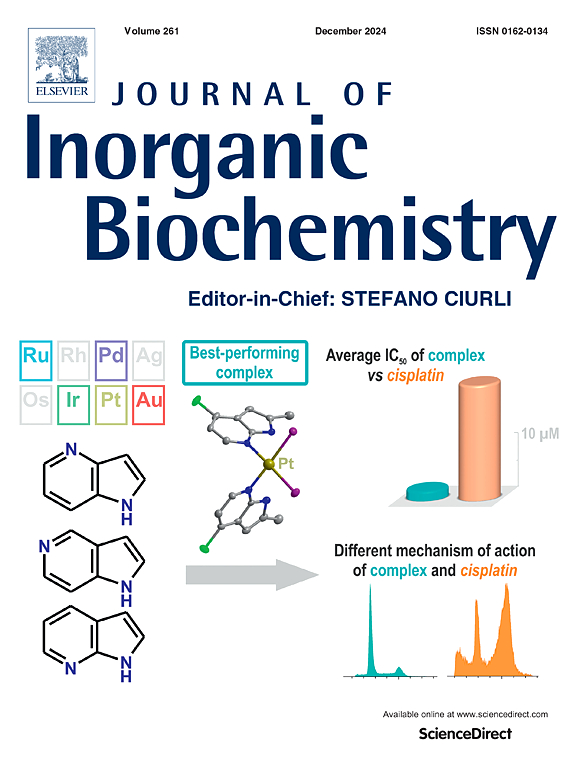The binding of kojic acid dimer and its Zn(II) and Cu(II) complexes at the beta-amyloid peptide: A DFT-based computational assessment
IF 3.2
2区 化学
Q2 BIOCHEMISTRY & MOLECULAR BIOLOGY
引用次数: 0
Abstract
The increasing number of people afflicted by Alzheimer's disease in the world requires a constant intensification of the efforts to seek for new agents capable of dismantling the molecular mechanisms underlying the onset and development of this neurodegenerative disorder. In this study, the binding of kojic acid dimer (KAD), and its adducts with Zn(II) and Cu(II) to the beta-amyloid peptide (Aβ) have been investigated by means of density functional theory-based computational approaches. We envisioned that the capability of KAD to inhibit the amyloid cascade may be exerted in concomitance and/or supported by the coordination of either Zn(II) or Cu(II). Thus, the structure and binding features of KAD-Zn and KAD-Cu metal complexes were computationally assessed to gain an atomistic insight of the possible Aβ inhibition. Our calculations evidenced that Zn(II), but not Cu(II), might act in concert with KAD in the binding of the Aβ peptide. Furthermore, we identified the Aβ13–20 region as a plausible binding site for KAD and KAD-Zn complexes, emphasizing its relevance for future experimental studies.

曲酸二聚体及其Zn(II)和Cu(II)配合物在β -淀粉样肽上的结合:基于dft的计算评估
世界上患有阿尔茨海默病的人数不断增加,需要不断加强努力,寻找能够分解这种神经退行性疾病发病和发展的分子机制的新药。本研究采用基于密度泛函理论的计算方法研究了曲酸二聚体(KAD)及其加合物Zn(II)和Cu(II)与β -淀粉样肽(Aβ)的结合。我们设想KAD抑制淀粉样蛋白级联的能力可能是在Zn(II)或Cu(II)的协同作用下协同发挥的。因此,计算评估了KAD-Zn和KAD-Cu金属配合物的结构和结合特征,以获得可能的Aβ抑制的原子性见解。我们的计算证明Zn(II),而不是Cu(II),可能在Aβ肽结合中与KAD协同作用。此外,我们确定了a β13 - 20区域可能是KAD和KAD- zn复合物的结合位点,强调了其与未来实验研究的相关性。
本文章由计算机程序翻译,如有差异,请以英文原文为准。
求助全文
约1分钟内获得全文
求助全文
来源期刊

Journal of Inorganic Biochemistry
生物-生化与分子生物学
CiteScore
7.00
自引率
10.30%
发文量
336
审稿时长
41 days
期刊介绍:
The Journal of Inorganic Biochemistry is an established international forum for research in all aspects of Biological Inorganic Chemistry. Original papers of a high scientific level are published in the form of Articles (full length papers), Short Communications, Focused Reviews and Bioinorganic Methods. Topics include: the chemistry, structure and function of metalloenzymes; the interaction of inorganic ions and molecules with proteins and nucleic acids; the synthesis and properties of coordination complexes of biological interest including both structural and functional model systems; the function of metal- containing systems in the regulation of gene expression; the role of metals in medicine; the application of spectroscopic methods to determine the structure of metallobiomolecules; the preparation and characterization of metal-based biomaterials; and related systems. The emphasis of the Journal is on the structure and mechanism of action of metallobiomolecules.
 求助内容:
求助内容: 应助结果提醒方式:
应助结果提醒方式:


